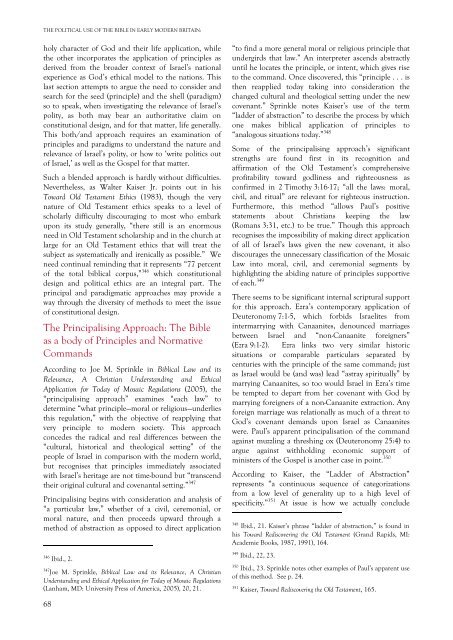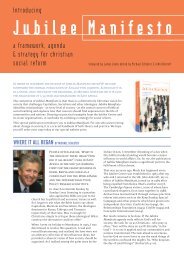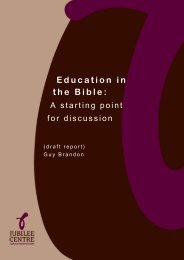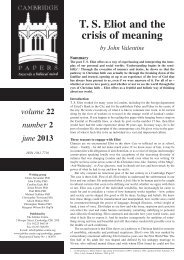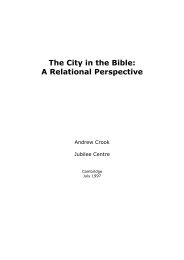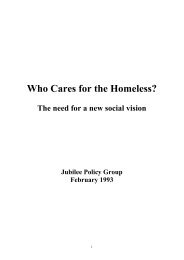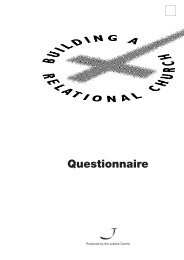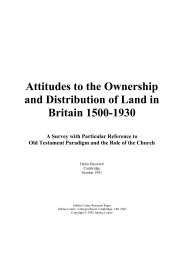Report Template - Jubilee Centre
Report Template - Jubilee Centre
Report Template - Jubilee Centre
You also want an ePaper? Increase the reach of your titles
YUMPU automatically turns print PDFs into web optimized ePapers that Google loves.
THE POLITICAL USE OF THE BIBLE IN EARLY MODERN BRITAIN:<br />
holy character of God and their life application, while<br />
the other incorporates the application of principles as<br />
derived from the broader context of Israel’s national<br />
experience as God’s ethical model to the nations. This<br />
last section attempts to argue the need to consider and<br />
search for the seed (principle) and the shell (paradigm)<br />
so to speak, when investigating the relevance of Israel’s<br />
polity, as both may bear an authoritative claim on<br />
constitutional design, and for that matter, life generally.<br />
This both/and approach requires an examination of<br />
principles and paradigms to understand the nature and<br />
relevance of Israel’s polity, or how to ‘write politics out<br />
of Israel,’ as well as the Gospel for that matter.<br />
Such a blended approach is hardly without difficulties.<br />
Nevertheless, as Walter Kaiser Jr. points out in his<br />
Toward Old Testament Ethics (1983), though the very<br />
nature of Old Testament ethics speaks to a level of<br />
scholarly difficulty discouraging to most who embark<br />
upon its study generally, “there still is an enormous<br />
need in Old Testament scholarship and in the church at<br />
large for an Old Testament ethics that will treat the<br />
subject as systematically and irenically as possible.” We<br />
need continual reminding that it represents “77 percent<br />
of the total biblical corpus,” 346 which constitutional<br />
design and political ethics are an integral part. The<br />
principal and paradigmatic approaches may provide a<br />
way through the diversity of methods to meet the issue<br />
of constitutional design.<br />
The Principalising Approach: The Bible<br />
as a body of Principles and Normative<br />
Commands<br />
According to Joe M. Sprinkle in Biblical Law and its<br />
Relevance, A Christian Understanding and Ethical<br />
Application for Today of Mosaic Regulations (2005), the<br />
“principalising approach” examines “each law” to<br />
determine “what principle—moral or religious—underlies<br />
this regulation,” with the objective of reapplying that<br />
very principle to modern society. This approach<br />
concedes the radical and real differences between the<br />
“cultural, historical and theological setting” of the<br />
people of Israel in comparison with the modern world,<br />
but recognises that principles immediately associated<br />
with Israel’s heritage are not time-bound but “transcend<br />
their original cultural and covenantal setting.” 347<br />
Principalising begins with consideration and analysis of<br />
“a particular law,” whether of a civil, ceremonial, or<br />
moral nature, and then proceeds upward through a<br />
method of abstraction as opposed to direct application<br />
346<br />
Ibid., 2.<br />
347<br />
Joe M. Sprinkle, Biblical Law and its Relevance, A Christian<br />
Understanding and Ethical Application for Today of Mosaic Regulations<br />
(Lanham, MD: University Press of America, 2005), 20, 21.<br />
“to find a more general moral or religious principle that<br />
undergirds that law.” An interpreter ascends abstractly<br />
until he locates the principle, or intent, which gives rise<br />
to the command. Once discovered, this “principle . . . is<br />
then reapplied today taking into consideration the<br />
changed cultural and theological setting under the new<br />
covenant.” Sprinkle notes Kaiser’s use of the term<br />
“ladder of abstraction” to describe the process by which<br />
one makes biblical application of principles to<br />
“analogous situations today.” 348<br />
Some of the principalising approach’s significant<br />
strengths are found first in its recognition and<br />
affirmation of the Old Testament’s comprehensive<br />
profitability toward godliness and righteousness as<br />
confirmed in 2 Timothy 3:16-17; “all the laws: moral,<br />
civil, and ritual” are relevant for righteous instruction.<br />
Furthermore, this method “allows Paul’s positive<br />
statements about Christians keeping the law<br />
(Romans 3:31, etc.) to be true.” Though this approach<br />
recognises the impossibility of making direct application<br />
of all of Israel’s laws given the new covenant, it also<br />
discourages the unnecessary classification of the Mosaic<br />
Law into moral, civil, and ceremonial segments by<br />
highlighting the abiding nature of principles supportive<br />
of each. 349<br />
There seems to be significant internal scriptural support<br />
for this approach. Ezra’s contemporary application of<br />
Deuteronomy 7:1-5, which forbids Israelites from<br />
intermarrying with Canaanites, denounced marriages<br />
between Israel and “non-Canaanite foreigners”<br />
(Ezra 9:1-2). Ezra links two very similar historic<br />
situations or comparable particulars separated by<br />
centuries with the principle of the same command; just<br />
as Israel would be (and was) lead “astray spiritually” by<br />
marrying Canaanites, so too would Israel in Ezra’s time<br />
be tempted to depart from her covenant with God by<br />
marrying foreigners of a non-Canaanite extraction. Any<br />
foreign marriage was relationally as much of a threat to<br />
God’s covenant demands upon Israel as Canaanites<br />
were. Paul’s apparent principalisation of the command<br />
against muzzling a threshing ox (Deuteronomy 25:4) to<br />
argue against withholding economic support of<br />
ministers of the Gospel is another case in point. 350<br />
According to Kaiser, the “Ladder of Abstraction”<br />
represents “a continuous sequence of categorizations<br />
from a low level of generality up to a high level of<br />
specificity.” 351 At issue is how we actually conclude<br />
348<br />
Ibid., 21. Kaiser’s phrase “ladder of abstraction,” is found in<br />
his Toward Rediscovering the Old Testament (Grand Rapids, MI:<br />
Academie Books, 1987, 1991), 164.<br />
349<br />
Ibid., 22, 23.<br />
350<br />
Ibid., 23. Sprinkle notes other examples of Paul’s apparent use<br />
of this method. See p. 24.<br />
351<br />
Kaiser, Toward Rediscovering the Old Testament, 165.<br />
68


